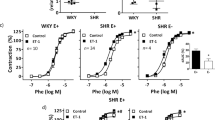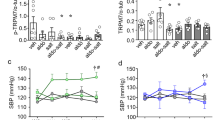Abstract
Hyperaldosteronism is associated with impaired vascular reactivity; however, the mechanisms by which aldosterone promotes endothelial dysfunction remain unknown. Glucose-6-phosphate dehydrogenase (G6PD) modulates vascular function by limiting oxidant stress to preserve bioavailable nitric oxide (NO•). Here we show that aldosterone (10−9–;10−7 mol/l) decreased endothelial G6PD expression and activity in vitro, resulting in increased oxidant stress and decreased NO• levels—similar to what is observed in G6PD-deficient endothelial cells. Aldosterone decreased G6PD expression by increasing expression of the cyclic AMP−response element modulator (CREM) to inhibit cyclic AMP−response element binding protein (CREB)-mediated G6PD transcription. In vivo, infusion of aldosterone decreased vascular G6PD expression and impaired vascular reactivity. These effects were abrogated by spironolactone or vascular gene transfer of G6pd. These findings demonstrate that aldosterone induces a G6PD-deficient phenotype to impair endothelial function; aldosterone antagonism or gene transfer of G6pd improves vascular reactivity by restoring G6PD activity.
This is a preview of subscription content, access via your institution
Access options
Subscribe to this journal
Receive 12 print issues and online access
$209.00 per year
only $17.42 per issue
Buy this article
- Purchase on Springer Link
- Instant access to full article PDF
Prices may be subject to local taxes which are calculated during checkout






Similar content being viewed by others
Change history
04 September 2009
In the version of this article initially published, the number of one of the grants listed in the Acknowledgments was incorrect; ‘HL55993’ should have been ‘P01 HL81587’. The error has been corrected in the HTML and PDF versions of the article.
References
Blacher, J. et al. Association between increased plasma levels of aldosterone and decreased systemic arterial compliance in subjects with essential hypertension. Am. J. Hypertens. 10, 1326–1334 (1997).
Duprez, D.A. et al. Inverse relationship between aldosterone and large artery compliance in chronically treated heart failure patients. Eur. Heart J. 19, 1371–1376 (1998).
Weber, K.T. Aldosteronism revisited: perspectives on less well-recognized actions of aldosterone. J. Lab. Clin. Med. 142, 71–82 (2003).
Farquharson, C.A. & Struthers, A.D. Spironolactone increases nitric oxide bioactivity, improves endothelial vasodilator dysfunction, and suppresses vascular angiotensin I/angiotensin II conversion in patients with chronic heart failure. Circulation 101, 594–597 (2000).
Struthers, A.D. Aldosterone-induced vasculopathy. Mol. Cell. Endocrinol. 217, 239–241 (2004).
Leopold, J.A., Cap, A., Scribner, A.W., Stanton, R.C. & Loscalzo, J. Glucose-6-phosphate dehydrogenase deficiency promotes endothelial oxidant stress and decreases endothelial nitric oxide bioavailability. FASEB J. 15, 1771–1773 (2001).
Leopold, J.A., Zhang, Y.Y., Scribner, A.W., Stanton, R.C. & Loscalzo, J. Glucose-6-phosphate dehydrogenase overexpression decreases endothelial cell oxidant stress and increases bioavailable nitric oxide. Arterioscler. Thromb. Vasc. Biol. 23, 411–417 (2003).
Criss, W.E. & McKerns, K.W. Inhibitors of the catalytic activity of bovine adrenal glucose-6- phosphate dehydrogenase. Biochim. Biophys. Acta 184, 486–494 (1969).
Liew, C.C. & Gornall, A.G. Effects of aldosterone on blood pressure and glucose-6-phosphate dehydrogenase activity of heart muscle. Can. J. Physiol. Pharmacol. 47, 193–197 (1969).
Xu, Y., Osborne, B.W. & Stanton, R.C. Diabetes causes inhibition of glucose-6-phosphate dehydrogenase via activation of PKA, which contributes to oxidative stress in rat kidney cortex. Am. J. Physiol. Renal Physiol. 289, F1040–F1047 (2005).
Guo, L., Zhang, Z., Green, K. & Stanton, R.C. Suppression of interleukin-1 beta-induced nitric oxide production in RINm5F cells by inhibition of glucose-6-phosphate dehydrogenase. Biochemistry 41, 14726–14733 (2002).
Macho, B. & Sassone-Corsi, P. Functional analysis of transcription factors CREB and CREM. Methods Enzymol. 370, 396–415 (2003).
Zhang, X. et al. Genome-wide analysis of cAMP-response element binding protein occupancy, phosphorylation, and target gene activation in human tissues. Proc. Natl. Acad. Sci. USA 102, 4459–4464 (2005).
Manna, P.R. et al. Regulation of steroidogenesis and the steroidogenic acute regulatory protein by a member of the cAMP response-element binding protein family. Mol. Endocrinol. 16, 184–199 (2002).
Klatt, P. et al. Characterization of heme-deficient neuronal nitric-oxide synthase reveals a role for heme in subunit dimerization and binding of the amino acid substrate and tetrahydrobiopterin. J. Biol. Chem. 271, 7336–7342 (1996).
Cai, S., Khoo, J., Mussa, S., Alp, N.J. & Channon, K.M. Endothelial nitric oxide synthase dysfunction in diabetic mice: importance of tetrahydrobiopterin in eNOS dimerisation. Diabetologia 48, 1933–1940 (2005).
Leopold, J.A. et al. Glucose-6-phosphate dehydrogenase modulates vascular endothelial growth factor-mediated angiogenesis. J. Biol. Chem. 278, 32100–32106 (2003).
Ding, H. et al. Endothelial dysfunction in the streptozotocin-induced diabetic apoE-deficient mouse. Br. J. Pharmcol. 146, 1110–1118 (2005).
Rousseau, M.F. et al. Beneficial neurohormonal profile of spironolactone in severe congestive heart failure: results from the RALES neurohormonal substudy. J. Am. Coll. Cardiol. 40, 1596–1601 (2002).
Silvestre, J.S. et al. Myocardial production of aldosterone and corticosterone in the rat. Physiological regulation. J. Biol. Chem. 273, 4883–4891 (1998).
Weber, K.T. Aldosterone in congestive heart failure. N. Engl. J. Med. 345, 1689–1697 (2001).
Massaad, C., Houard, N., Lombes, M. & Barouki, R. Modulation of human mineralocorticoid receptor function by protein kinase A. Mol. Endocrinol. 13, 57–65 (1999).
Booth, R.E., Johnson, J.P. & Stockand, J.D. Aldosterone. Adv. Physiol. Educ. 26, 8–20 (2002).
Mioduszewska, B., Jaworski, J. & Kaczmarek, L. Inducible cAMP early repressor (ICER) in the nervous system–a transcriptional regulator of neuronal plasticity and programmed cell death. J. Neurochem. 87, 1313–1320 (2003).
Boissel, J.P., Bros, M., Schrock, A., Godtel-Armbrust, U. & Forstermann, U. Cyclic AMP-mediated upregulation of the expression of neuronal NO synthase in human A673 neuroepithelioma cells results in a decrease in the level of bioactive NO production: analysis of the signaling mechanisms that are involved. Biochemistry 43, 7197–7206 (2004).
Shepard, J.D., Liu, Y., Sassone-Corsi, P. & Aguilera, G. Role of glucocorticoids and cAMP-mediated repression in limiting corticotropin-releasing hormone transcription during stress. J. Neurosci. 25, 4073–4081 (2005).
Ding, B. et al. A positive feedback loop of phosphodiesterase 3 (PDE3) and inducible cAMP early repressor (ICER) leads to cardiomyocyte apoptosis. Proc. Natl. Acad. Sci. USA 102, 14771–14776 (2005).
Nagata, D. et al. Molecular mechanism of the inhibitory effect of aldosterone on endothelial NO synthase activity. Hypertension 48, 165–171 (2006).
Sun, Y. et al. Aldosterone-induced inflammation in the rat heart: role of oxidative stress. Am. J. Pathol. 161, 1773–1781 (2002).
Schafer, A. et al. Addition of the selective aldosterone receptor antagonist eplerenone to ACE inhibition in heart failure: effect on endothelial dysfunction. Cardiovasc. Res. 58, 655–662 (2003).
Matsui, R. et al. Glucose-6 phosphate dehydrogenase deficiency decreases the vascular response to angiotensin II. Circulation 112, 257–263 (2005).
Nishizaka, M.K., Zaman, M.A., Green, S.A., Renfroe, K.Y. & Calhoun, D.A. Impaired endothelium-dependent flow-mediated vasodilation in hypertensive subjects with hyperaldosteronism. Circulation 109, 2857–2861 (2004).
Abiose, A.K. et al. Effect of spironolactone on endothelial function in patients with congestive heart failure on conventional medical therapy. Am. J. Card. 93, 1564–1566 (2004).
Macdonald, J.E., Kennedy, N. & Struthers, A.D. Effects of spironolactone on endothelial function, vascular angiotensin converting enzyme activity, and other prognostic markers in patients with mild heart failure already taking optimal treatment. Heart 90, 765–770 (2004).
Davies, J.I., Band, M., Morris, A. & Struthers, A.D. Spironolactone impairs endothelial function and heart rate variability in patients with type 2 diabetes. Diabetologia 47, 1687–1694 (2004).
Zhang, Z., Apse, K., Pang, J. & Stanton, R.C. High glucose inhibits glucose-6-phosphate dehydrogenase via cAMP in aortic endothelial cells. J. Biol. Chem. 275, 40042–40047 (2000).
Garnier, A. et al. Cardiac specific increase in aldosterone production induces coronary dysfunction in aldosterone synthase-transgenic mice. Circulation 110, 1819–1825 (2004).
Forgione, M.A. et al. The A326G (A+) variant of the glucose-6-phosphate dehydrogenase gene is associated with endothelial dysfunction in African Americans. J. Am. Coll. Cardiol. 41, 249A (2003).
Leopold, J.A. & Loscalzo, J. Cyclic strain modulates resistance to oxidant stress by increasing G6PDH expression in smooth muscle cells. Am. J. Physiol. Heart Circ. Physiol. 279, H2477–H2485 (2000).
Zhang, Y.Y. et al. Expression of 5-lipoxygenase in pulmonary artery endothelial cells. Biochem. J. 361, 267–276 (2002).
Dong, Q.G. et al. A general strategy for isolation of endothelial cells from murine tissues. Characterization of two endothelial cell lines from the murine lung and subcutaneous sponge implants. Arterioscler. Thromb. Vasc. Biol. 17, 1599–1604 (1997).
Zhang, Z., Yu, J. & Stanton, R.C. A method for determination of pyridine nucleotides using a single extract. Anal. Biochem. 285, 163–167 (2000).
Zhang, M.X. et al. Regulation of endothelial nitric oxide synthase by small RNA. Proc. Natl. Acad. Sci. USA 102, 16967–16972 (2005).
Uittenbogaard, A., Shaul, P.W., Yuhanna, I.S., Blair, A. & Smart, E.J. High density lipoprotein prevents oxidized low density lipoprotein-induced inhibition of endothelial nitric-oxide synthase localization and activation in caveolae. J. Biol. Chem. 275, 11278–11283 (2000).
Hou, J., Speirs, H.J., Seckl, J.R. & Brown, R.W. Sgk1 gene expression in kidney and its regulation by aldosterone: spatio-temporal heterogeneity and quantitative analysis. J. Am. Soc. Nephrol. 13, 1190–1198 (2002).
Michel, F. et al. Aldosterone enhances ischemia-induced neovascularization through angiotensin II-dependent pathway. Circulation 109, 1933–1937 (2004).
Eberhardt, R.T. et al. Endothelial dysfunction in a murine model of mild hyperhomocyst(e)inemia. J. Clin. Invest. 106, 483–491 (2000).
Virdis, A. et al. Effect of hyperhomocystinemia and hypertension on endothelial function in methylenetetrahydrofolate reductase-deficient mice. Arterioscler. Thromb. Vasc. Biol. 23, 1352–1357 (2003).
Acknowledgements
This work was supported in part by the US National Institutes of Health (grants HL61828, HL58976, P01 HL81587, HV28178 to J.L.; HL04399 and HL081110 to J.A.L.; HL067297, HL071775 and HL073756 to R.L.; and DK053480-05 to R.C.S.) and by a Grant-in-Aid from the American Heart Association (to J.A.L.).
Author information
Authors and Affiliations
Contributions
J.A.L. designed the study, supervised the project, conducted experiments and wrote the manuscript. A.D. contributed to the in vitro and in vivo experiments. B.A.M., A.W.S., D.E.H. and R.C.S contributed to the in vitro experiments. R.L. contributed to the in vivo experiments. B.P. contributed to data interpretation. J.L. contributed to data interpretation and manuscript critique.
Corresponding author
Ethics declarations
Competing interests
B.P. is a consultant for Pfizer, Novartis, Alteon and Astra Zeneca.
Supplementary information
Supplementary Fig. 1
Aldosterone decreases G6PD expression in human coronary artery endothelial cells. (PDF 47 kb)
Supplementary Fig. 2
Aldosterone decreases G6PD expression by protein kinase A activation. (PDF 56 kb)
Supplementary Fig. 3
Inhibition of CREB or CREM expression by siRNA. (PDF 68 kb)
Supplementary Fig. 4
Aldosterone and CREB activation: upstream signaling kinases and downstream transcription factors. (PDF 73 kb)
Supplementary Fig. 5
Source of reactive oxygen species in aldosterone-treated cells. (PDF 43 kb)
Supplementary Fig. 6
Spironolactone increases G6PD activity. (PDF 28 kb)
Supplementary Fig. 7
G6PD overexpression preserves G6PD activity in vitro. (PDF 49 kb)
Supplementary Fig. 8
G6PD overexpression preserves G6PD activity in vivo. (PDF 52 kb)
Rights and permissions
About this article
Cite this article
Leopold, J., Dam, A., Maron, B. et al. Aldosterone impairs vascular reactivity by decreasing glucose-6-phosphate dehydrogenase activity. Nat Med 13, 189–197 (2007). https://doi.org/10.1038/nm1545
Received:
Accepted:
Published:
Issue Date:
DOI: https://doi.org/10.1038/nm1545
This article is cited by
-
Increasing NADPH impairs fungal H2O2 resistance by perturbing transcriptional regulation of peroxiredoxin
Bioresources and Bioprocessing (2022)
-
Role of high-salt diet in non-alcoholic fatty liver disease: a mini-review of the evidence
European Journal of Clinical Nutrition (2022)
-
Cardiovascular and Renal Outcomes with Finerenone, a Selective Mineralocorticoid Receptor Antagonist
Cardiology and Therapy (2022)
-
Left ventricular remodeling and dysfunction in primary aldosteronism
Journal of Human Hypertension (2021)
-
Pathogenesis and treatment of primary aldosteronism
Nature Reviews Endocrinology (2020)



